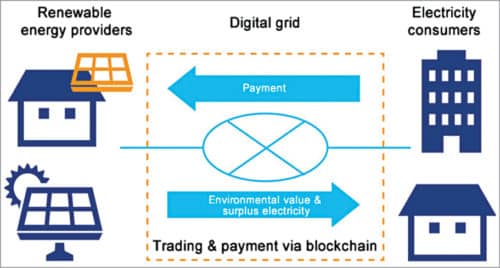Besides doing away with the need for a centralised electric vehicle (EV) charging infrastructure, blockchain eases trading between consumers and charging stations or transport providers.
Ever since the concept of cryptocurrencies became popular with the hype around Bitcoin, its underlying technology, blockchain, has found application in numerous other sectors such as healthcare, real estate, tourism and media, among others, for data maintenance and security.
Data in a blockchain is added in chronological order in the form of blocks, which ensures immutability. In addition to this, updates are made to the blockchain only after consensus among all peers in the network, which makes the database decentralised. New additions are linked to previous ones through cryptography, which ensures security. Data formats can also be standardised across different institutions. All these features promote transparent sharing of information and establish trust among its users.
In the renewable energy sector too, established companies as well as startups, such as Acciona Energy, Irene Energy, The Sun Exchange, Electrify Asia, Greeneum and Iberdrola, have realised the potential of blockchain. Several attempts are being made to utilise it as a tool for catalysing the transition to green energy. According to a recent report from Research and Markets, blockchain in the energy market was valued at US$ 518.6 million in 2018 and is projected to grow at a CAGR of 54.09 per cent during the forecast period from 2019 to 2024.

A smart electricity grid employs renewable energy as the preferred choice of energy. Renewable energy acts as backup power when the central grid fails to balance supply and demand. As more people get renewable energy installations in their homes, the number of prosumers in the market who can sell the excess energy generated increases. For instance, solar power from rooftop panels attached to a computer can provide energy at a low cost during the day when sunlight is in abundance.
This decentralisation of energy systems can create stress on traditional electricity grids. Blockchain can stabilise the grid through peer-to-peer (P2P) transaction platforms that enable buying and selling of energy generated from even small-scale installations. Pando by Lo3 Energy is one such platform that allows pooling of local distributed energy resources and optimises the grid at the community level.
By linking energy grids to blockchain and using smart meters, data sharing is possible in real time. Electricity generated and consumed is tracked and recorded in a tamper-proof way, which ensures accountability between sellers and buyers. Customer energy usage patterns can be identified, which makes it easier to supply the right amount of energy and reduce inequality in both areas, with or without access to central grids. Consumers can make more informed decisions as they can compare supplies from different energy providers, which drives competition.
Small producers and new players can also get green certificates for trading automatically through blockchain, which improves chances of higher investment in this field. This promotes local consumption and boosts growth of clean energy into the mainstream while simultaneously reducing transmission losses and the need for expensive infrastructure.
Different initiatives are being taken in India as well. For example, Uttar Pradesh government has collaborated with Australia’s Power Ledger to pilot solar energy trading through blockchain integrated with smart meter systems. Phase I of the pilot project is in development with the aim to establish a two-sided energy market.
Another initiative is by power utility company BSES Rajdhani Power Ltd, which plans to use a blockchain-powered ledger for a New-Delhi-based pilot project for P2P solar power trading.
Blockchain can serve as a boon for electric vehicles (EVs), too, through decentralisation. Besides doing away with the need for a centralised EV charging infrastructure, it eases trading between consumers and charging stations or transport providers.
Yet, to be successful on a large scale, several issues need to be solved. With P2P trading, many new payment platforms for pre-paid meters and pay-as-you-go solutions may come up. Blockchain eliminates the need for a third party, which challenges traditional market roles like those of metering point operators and suppliers.
Proper governance is necessary to ensure smart management of energy needs and maintain power system stability. Smart grids need user information, which also requires strict protocols to maintain user anonymity and ensure privacy.






